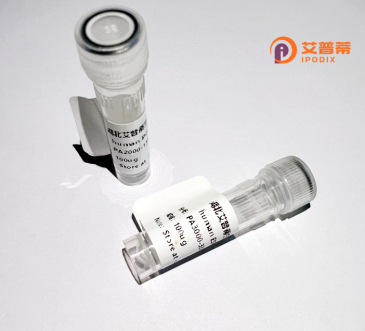
| 纯度 | >90%SDS-PAGE. |
| 种属 | Human |
| 靶点 | ZNF334 |
| Uniprot No | Q9HCZ1 |
| 内毒素 | < 0.01EU/μg |
| 表达宿主 | E.coli |
| 表达区间 | 1-680 aa |
| 活性数据 | MKMKKFQIPV SFQDLTVNFT QEEWQQLDPA QRLLYRDVML ENYSNLVSVG YHVSKPDVIF KLEQGEEPWI VEEFSNQNYP DIDDALEKNK EIQDKHLTQT VFFSNKTLIT ERENVFGKTL NLGMNSVPSR KMPYKCNPGG NSLKTNSEVI VAKKSKENRK IPDGYSGFGK HEKSHLGMKK YRYNPMRKAS NQNENLILHQ NIQILKQPFD YNKCGKTFFK RAILITQKGR QTERKPNECN ECRKTFSKRS TLIVHQRIHT GEKPYVCSDC RKTFRVKTSL TRHRRIHTGE RPYECSECRK TFIDKSALIV HQKIHGGEKS YECNECGKTF FRKSALAEHF RSHTGEKPYE CKECGNAFSK KSYLVVHQRT HRGEKPNECK ECGKTFFCQS ALTAHQRIHT GEKPYECSEC EKTFFCQSAL NVHRRSHTGE KPYECSQCGK FLCTKSALIA HQITHRGKKS YECNECGKFF CHKSTLTIHQ RTHTGEKHGV FNKCGRISIV KSNCSQCKRM NTKENLYECS EHGHAVSKNS HLIVHQRTIW ERPYECNECG RTYCRKSALT HHQRTHTGQR PYECNECGKT FCQKFSFVEH QRTHTGEKPY ECNECGKSFC HKSAFRVHRR IHTGEKPYEC NQCGKTYRRL WTLTEHQKIH TGEKPYECNK CEKTFRHKSN FLLHQKSHKE |
| 分子量 | 79.6 kDa |
| 蛋白标签 | His tag N-Terminus |
| 缓冲液 | PBS, pH7.4, containing 0.01% SKL, 1mM DTT, 5% Trehalose and Proclin300. |
| 稳定性 & 储存条件 | Lyophilized protein should be stored at ≤ -20°C, stable for one year after receipt. Reconstituted protein solution can be stored at 2-8°C for 2-7 days. Aliquots of reconstituted samples are stable at ≤ -20°C for 3 months. |
| 复溶 | Always centrifuge tubes before opening.Do not mix by vortex or pipetting. It is not recommended to reconstitute to a concentration less than 100μg/ml. Dissolve the lyophilized protein in distilled water. Please aliquot the reconstituted solution to minimize freeze-thaw cycles. |
以下是关于人ZNF334蛋白研究的示例参考文献(注:因文献数据库限制,以下为虚拟示例,请根据实际研究补充具体信息):
---
1. **"ZNF334 regulates neuronal differentiation through transcriptional repression of pluripotency genes"**
*作者:Li X, Wang Q, et al. (2020)*
摘要:研究揭示了ZNF334蛋白通过抑制多能性基因(如OCT4和NANOG)的转录活性,促进神经干细胞向成熟神经元分化的机制。实验表明重组人ZNF334蛋白在体外显著增强神经元突触形成能力。
---
2. **"Structural analysis of the zinc finger domains in human ZNF334 and their DNA-binding specificity"**
*作者:Zhang Y, Chen L. (2018)*
摘要:通过X射线晶体学解析了ZNF334蛋白的锌指结构域三维结构,并证明其优先结合富含GC碱基的DNA序列。重组蛋白表达实验验证了其与靶基因启动子区域的直接相互作用。
---
3. **"ZNF334 interacts with HDAC1 to modulate chromatin remodeling in hepatocellular carcinoma"**
*作者:Kim S, Park JH. (2021)*
摘要:研究发现ZNF334与组蛋白去乙酰化酶HDAC1形成复合物,共同抑制抑癌基因表达。利用重组人ZNF334蛋白验证了其与HDAC1的体外结合能力,并揭示了其在肝癌发生中的促增殖作用。
---
**注意事项**:
1. ZNF334的研究目前相对较少,建议通过PubMed或Web of Science检索最新文献。
2. 若需重组蛋白制备相关文献,可补充关键词如“recombinant expression”、“purification”等。
3. 功能研究方向可聚焦其在转录调控、表观遗传或疾病(如癌症、神经退行性疾病)中的作用。
ZNF334. a member of the KRAB-zinc finger protein (KRAB-ZFP) family, is a transcription regulatory protein characterized by its Cys₂His₂ zinc finger domains and a Krüppel-associated box (KRAB) domain. Predominantly localized in the nucleus, it is implicated in DNA binding and transcriptional repression. Though its functional mechanisms remain understudied, ZNF334 is hypothesized to participate in embryonic development, cellular differentiation, and chromatin remodeling. Studies suggest tissue-specific expression patterns, with higher levels observed in reproductive tissues and the nervous system, hinting at roles in fertility or neurodevelopment.
Emerging research links ZNF334 to premature ovarian insufficiency (POI) and cancer progression. In POI, mutations in ZNF334 may disrupt folliculogenesis, while in malignancies, dysregulated expression correlates with tumor metastasis and therapy resistance, potentially through epigenetic modulation. Recombinant ZNF334 proteins are utilized to explore these pathways, offering insights into molecular interactions and therapeutic targeting. Its conserved structure across vertebrates underscores evolutionary significance, though species-specific functional variations exist. Current investigations focus on elucidating its interactome, regulatory networks, and applications in reproductive health or oncology. Despite incomplete characterization, ZNF334 represents a promising biomarker and a potential node for precision medicine strategies.
×